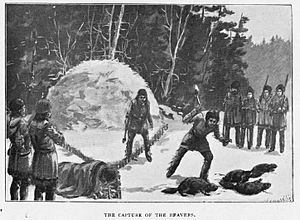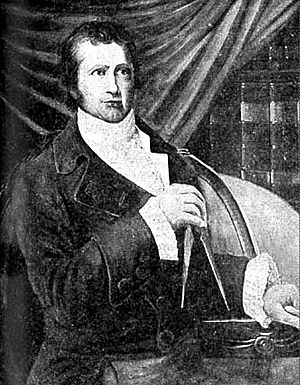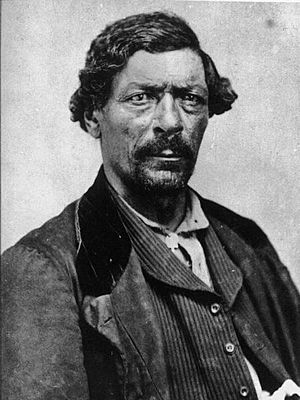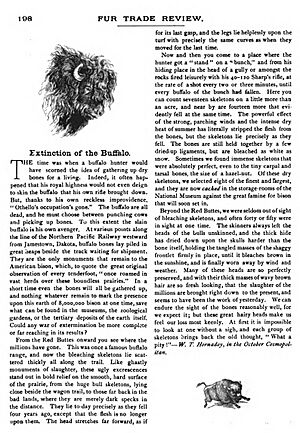Fur trade in Montana facts for kids
The fur trade in Montana was a very important part of the area's history. It happened from about 1800 to the 1850s. This time also marks the first big meetings between Native American groups and people from Europe. British and Canadian traders came from the north. They focused on trading with Native Americans. These groups often trapped beavers and other animals themselves. American traders moved up the Missouri River. They wanted to get to the rich Upper Missouri River region before the British and Canadians.
Native American groups reacted in different ways to the fur traders. They usually tried to get what was best for their own people. Often, different tribes worked well with traders. But sometimes, conflicts happened, especially when Native American interests were threatened. A good example of conflict was between American traders and the Blackfeet. This was especially true for the Blood people. American traders sometimes misunderstood Native American interests. This led to violence and fighting.
The fur trade brought more interactions between Native Americans and people of American and European backgrounds. A new economic system, called capitalism, was introduced. This changed Native American cultures. Also, serious illnesses spread, which caused many deaths. The numbers of beavers, and later bison, dropped a lot. This happened in the area that later became Montana.
Contents
Fur Trade and Native Americans in Montana
At the start of the 1800s, the North American fur trade was growing. It was moving towards what is now Montana from two directions. British and Canadian fur trade companies, like the Hudson's Bay Company and the North West Company, moved west and south. They came from their main areas on the Saskatchewan River. At the same time, American trappers and traders followed the path of the Lewis and Clark Expedition. They went up the Missouri River from their base in St. Louis.
These traders competed to trap animals with valuable fur. The American beaver was especially important. They also competed to make trade deals with the many Native American groups in the region. They hoped to control the market for these rich resources. The Native American groups in the area, like the Piegan (often called "Blackfeet"), the Crow, the Salish, and the Kootenai, tried to keep control of their lands. Their lands and resources supported their people and way of life. Each group took part in the fur trade in different ways. But all were changed by the important trading relationships. These relationships grew from about 1805 through the 1860s.
Native American Women in the Fur Trade
Native American women in Montana played a very important role in the fur trade. They helped with trade, understood different cultures, and made or used trade goods and food. Over time, a special fur trade society grew around trading posts. It became common for European-American men to marry women from different tribes. These marriages and the families that grew from them made political and economic ties stronger. Many Native American women had important positions and influence. But they also faced dangers like violence and illnesses.
Some well-known women include Natawista. In 1840, she married Major Alexander Culbertson, who was in charge of Fort Union. Another was Wambdi Autepewin, a Lakota woman. She was known for her skills as a mediator. Many other women made important clothes and food. They prepared animal skins for market. They also shared their knowledge of local plants, animals, and geography. They were deeply involved in the cultural exchange of the trade.
British and Canadian Traders
Even as Lewis and Clark crossed the Rocky Mountains in 1805, a French Canadian trapper was exploring. His name was François-Antoine Larocque. He worked for the North West Company. He explored part of the Yellowstone River area in what is now southeastern Montana. He wanted to make trade deals with Native Americans there, especially the Crow. His trip was successful. But Larocque's long-term plans failed. It was hard to compete with the Hudson's Bay Company and strong American fur traders.
The North West Company had more success west of the Continental Divide. They mostly avoided lands in the Louisiana Purchase. The Nor'Westers were led by David Thompson, a geographer from Wales. They worked their way to the start of the Saskatchewan River. Then they turned southwest into the start of the Columbia River. This was the western edge of the British fur trade's Columbia District.
Thompson's men came into present-day northwestern Montana in 1808. They built a trading post on the Kootenai River. This was near what is now Libby, Montana. They traded with the Native Americans of the same name. In November 1809, Thompson himself built the most important post in the area. It was called Saleesh House. It was on the Clark Fork River near what is now Thompson Falls, Montana. After many trips and making very accurate maps of the Clark Fork, Kootenai, and Flathead rivers, Thompson left the region for good in 1812. Because of Thompson's work and the continued efforts of the North West Company, and later the Hudson's Bay Company, this region was controlled by the British and Canadian fur trade for many years.
American Traders and Trappers
Manuel Lisa
American fur traders quickly moved up the Missouri River. This happened after the Louisiana Purchase and Lewis and Clark's exploration. The first American fur post in what is now Montana was built in November 1807. It was at the meeting point of the Yellowstone and Big Horn rivers. Manuel Lisa and his traders built it. Lisa called it Fort Remon for his son. But it was also known as Lisa's Fort or Fort Manuel.
From this post, Lisa hoped to build a small trading empire for his new Missouri Fur Company. His dream did not last. He and his men were the first of many American fur traders to be attacked. Groups of Piegan, Blood, and Gros Ventre attacked them. The post at the mouth of the Big Horn was left by 1811. Lisa's efforts ended in failure.
Andrew Henry, William H. Ashley, and Jedediah Smith
It was against federal law for non-Native Americans to hunt in Indian country. But federal officials often ignored this rule. They wanted to encourage Americans to settle the frontier and push out the British. In 1822, Andrew Henry and William H. Ashley formed a partnership. They wanted to enter the fur trade. They got a license to "carry on trade with the Indians up the Missouri." But their plan was to rely mostly on non-Native American trappers. They would depend less on direct trade with Native Americans. Henry and Ashley's trappers included Jim Bridger, Jedediah Strong Smith, and David Edward Jackson. Later, William Sublette and James Beckwourth joined them.
Henry and Ashley set up operations on the upper Missouri River at Fort Henry. Most of the men stayed there through the winter of 1822-23. Smith and some others went further up the Missouri. They reached the mouth of the Musselshell River in central Montana. They camped and trapped there through the winter and spring. They did not have any notable encounters with Native American groups. However, in the spring of 1823, Henry took a group further up the Missouri to the Great Falls. He tried to build a trading post. But an attack by the Piegans pushed him back. They went back to Fort Henry. But they soon left it. They built a new post two miles up the Yellowstone from the old Fort Remon. This was near what is now Custer, Montana. They traded with the more friendly Crow. The rest of the Ashley-Henry men focused on trapping in the Snake River country of present-day Idaho. They also trapped along rivers and streams in present-day Wyoming and Utah. So Henry arranged a rendezvous (a meeting place) in the spring of 1824. It was along the Sweetwater River in Wyoming. He collected the winter's furs. He made it back to St. Louis with half of them. Then he retired from the fur business.
After Henry retired, Ashley stopped using trading posts. He started the free trapping and rendezvous system in 1825. He took Smith as a partner. The new partnership avoided the more dangerous areas to the north. But the next year, in 1826, Smith, Sublette, and Jackson took over the company. While Smith was on his trips to the southwest, Jackson, Sublette, and Robert Campbell made trips into Montana. In 1829, Smith led a trapping trip into Piegan country. The next year, Smith and his partners sold their company. Thomas Fitzpatrick, Baptiste Gervais, Jim Bridger, Milton Sublette, and Henry Fraeb bought it. They named it the Rocky Mountain Fur Company. They set out with 200 men into the Great Falls area. The hunt was successful. But another attempt the next year failed. The Crows ran off their horses.
American Fur Company
John Jacob Astor's American Fur Company (AFC) started operations in St. Louis in 1822. By 1828, they arrived in the upper Missouri River region. Kenneth McKenzie, a Scotsman, wanted to get into the Upper Missouri trade. This was a valuable prize of the Western fur trade. He built what became Fort Union. It was near where the Missouri and Yellowstone rivers meet. The Piegan were surprisingly ready to trade with the AFC. In 1830, McKenzie made a deal with a Piegan group. He sent James Kipp to the mouth of the Marias River in 1831. Kipp was to set up a trading post on Piegan lands.
The AFC soon built a similar post on the Yellowstone to trade with the Crow. In 1832, the paddle steamer Yellowstone was the first to reach Fort Union. Steamboats could carry larger loads. This gave the AFC a big advantage in transportation after that.
Astor's company controlled the trade in the entire Missouri River region. They took the profitable Upper Missouri trade from the Hudson's Bay Company traders to the north. These traders had traded with the Piegan for decades. The Rocky Mountain Fur Company was the AFC's main American rival. But they could not match the AFC's resources. So they sold their company in 1834.
Impact of the Fur Trade in Montana
The fur trade coming to Montana had several big results. First, the land and its resources became better known. Maps were filled in and became more accurate. As Montana historian K. Ross Toole said, "Before the settler's wagon ever rolled a mile, before the miner found his first gold, before the government allowed a single road or trail, this wild land had been traveled and mapped."
A negative result of the trade was its impact on fur-bearing animals. First, the beaver population dropped. Later, the American bison or buffalo populations were pushed to the edge of extinction. The worst physical result was the spread of European diseases like smallpox. Traders and trappers increasingly spread these illnesses to Native Americans.
Finally, for the Native American groups who survived, the fur trade brought more Western European ideas. These included ideas about commerce (business) and religion. The beaver trade was part of global capitalism. It also indirectly led to the spread of Roman Catholic Christianity to some tribes. These changes greatly affected the Native Americans of the region. They challenged their already difficult way of life and changed their world forever.






